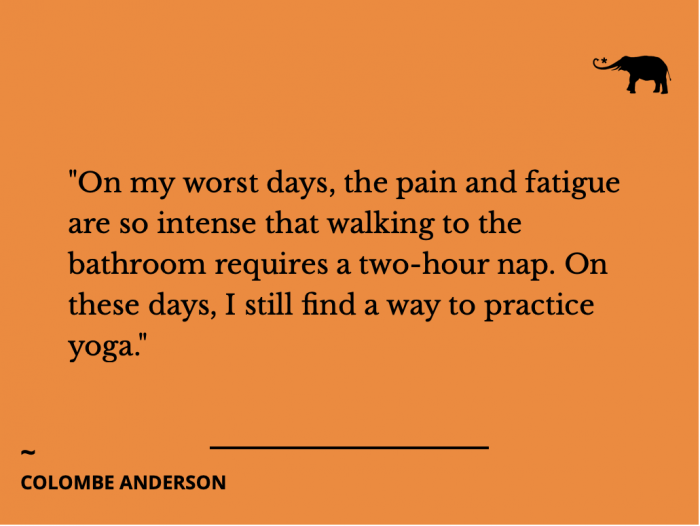I live with chronic pain.
At 21, I was diagnosed with endometriosis; at 30, celiac disease; at 32, I had a pacemaker fitted; at 34, they diagnosed graves disease; at 36, fibromyalgia; and at 40, osteoarthritis.
Thirty was when I discovered yoga—I was told by a doctor to try yoga to help heal a broken tailbone. He was right; through practicing yoga on the mat, I not only healed my broken tailbone, but also found a life-long practice that gets me through each day.
On my worst days, the pain and fatigue are so intense that walking to the bathroom requires a two-hour nap. On these days, I still find a way to practice yoga, because yoga is so much more than asana, the physical aspect of yoga.
If you’re breathing, you’re doing yoga.
Through yoga I learned that I was a reverse breather. Learning to breathe properly was such an awakening, and critical in managing my pain.
Through meditation I can transport myself away from the pain. I clear my mind, focus on my breath, and I’m transported to calm.
The yamas and the nyamas teach me gratitude, to be thankful for the gifts my body gives me, and to not judge my body for what it can’t do.
But what about asana? How can I practice that through the pain, the stiffness, the inability of movement? Asana gives me the movement I need. All of us, but especially those of us who suffer with chronic pain, need movement everyday. The less movement we have, the worse our bodies become.
The first thing we need to do is let go of the idea that we need to be able to do 30 poses while in a headstand. There are many ways to modify, or as I like to say “customize,” a pose to make it work for our body. There are props for yoga—chair yoga is a thing and it’s wonderful.
If you go to a class, ask the instructor for tips on how to modify or customize the moves that don’t work for you, and hit YouTube to find some videos.
Never let the voice inside your head tell you you can’t, because I promise you, once you discover what yoga can do for you, you will never look back.
I came to yoga because of a broken tailbone, but I stayed with yoga because it heals my body, and now I teach yoga because I want the world to know that it is for everybody—no matter what level you are at, how flexible, or how mobile.
Yoga has changed my life—it has saved my life. What can it do for you?











Read 4 comments and reply